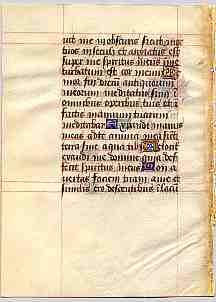

This shows the recto and verso of a leaf from a book of hours of the late 15th century, somewhere around 1450 to 1475, from France, probably Limoges. The vellum is quite thick and solid, but nevertheless has been worked until it is quite translucent. The red ink ruling grid for the writing is very clear to see. The language is Latin and the script is a very laboured and mannered bâtarde with many decorative flourishes which make it into a rather grand production, but in the opinion of this humble writer, neither enhance the aesthetics nor improve legibility.
There is a lavish sprinkling of illuminated letters, some of which have been built up in the traditional way with gesso and gold leaf over an inticately painted background to give an embossed effect. Others have been simply painted in gold ink on a coloured background. One assumes that the book once had the usual array of elaborate miniatures, but heaven knows whose art collection they are in now.
The text is from the Seven Penitential Psalms. These are not part of the actual hours, but special prayers for when the owner was feeling especially penitential, such as after sacking a neighbour's castle or feeling the shadow of mortality looming. The text shows the end of Psalm 129 from the Vulgate Bible, a prompt for the prayer Gloria Patri, a rubric and it then proceeds to Psalm 142 (Psalm 130 and Psalm 143 in a modern Bible).
| overview | text | alphabet | abbreviations | exercises | transcript | translation |
If you are looking at this page without frames, there is more information about medieval writing to be found by going to the home page (framed) or the site map (no frames).